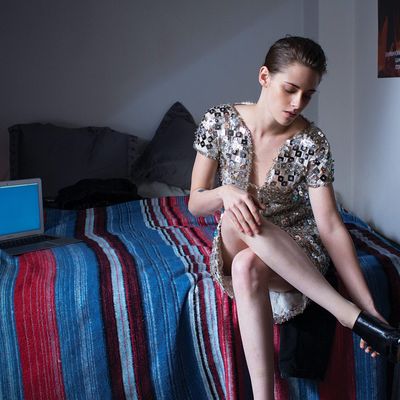
Kristen Stewart is practically the only person in Olivier Assayas’s haunted-soul saga Personal Shopper, and she plays a young woman without an identity. As in the same director’s Clouds of Sils Maria, she’s an American living in Europe and working as an adjunct to a rich and famous person, in this case a brusque socialite who’s rarely around and for whom she selects fabulously expensive clothing and accessories. Stewart’s character, Maureen, cannot try the clothing on, though. It’s forbidden. And there’s another void in her life. She has lost her twin, Lewis, a brother who promised he’d reach out to her from the beyond if such a thing turned out to exist. Maureen — an amateur medium — thinks it does, and she has been feeling a presence, something watching her. The problem is that he/she/it does not seem particularly fraternal.
If you have a penchant for mood pieces that flirt with genre but are too pretentious to deliver the full climactic payload, Personal Shopper is for you. I loved nearly all of it, disposed to forgive Assayas his arty withholding for the pleasure of watching Stewart through his eyes. He’s a demon for good actresses who are in tune with a certain kind of spiritual indefinition — a vacuum that drives them into perilous psychological (and often physical) realms. You can imagine Assayas gazing at Stewart in their last project and thinking, I would love to make a movie that dislocates her in every way imaginable and then see how she fills the void.
Tantalizingly, as it turns out. Not so long ago, Stewart starred in a movie called Catch That Kid, and something in her will always resist capture. It’s not that she’s estranged from her own body but squirmy inside it, with an eye for a potential escape hatch. Her Maureen vaguely hunches in her jeans and leather jacket, hands in pockets, as if trying to disappear into her clothes. When she finally slips into her employer’s outfits, she’s both a glamorous icon and a skinny little girl playing dress-up. Late in Personal Shopper, Maureen’s search for an identity has a weird offscreen correlative: In a tense encounter with a homicide detective, Stewart gets all blurty in the manner of Jesse Eisenberg, her co-star in Adventureland, American Ultra, and Café Society. Is she consciously channeling Eisenberg, or has he momentarily possessed her, like an absent twin? It’s altogether ooky.
Although Maureen is fascinated by the work of a female Swedish artist determined to create “abstract paintings from higher levels of consciousness,” the poltergeists are surprisingly literal, swirling around and vomiting ectoplasm as in a CGI-heavy Disney picture. That Assayas uses such genre tropes with relish makes it all the more irritating that he shrugs off the movie’s murder mystery, leaving a major encounter behind closed doors. The ambivalence about what to show and what to withhold is so damn French I want to throttle him. But just because this is an unsatisfying film doesn’t mean it’s not a beauty.
*This article appears in the March 6, 2017, issue of New York Magazine.


